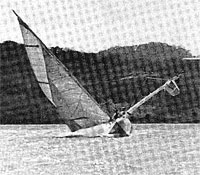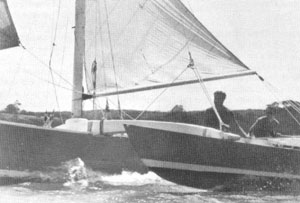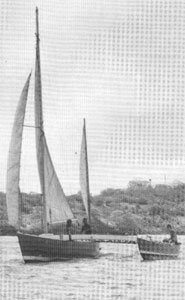
PROA DAYS on Freedom's Child This article was published in Multihull International, February 1974, reprinted from Cruising Association Bulletin. (click images for larger views)
It was definitely a case of love at first sight, to see her was to be filled with desire. She lay alongside the yacht club jetty, casting bright yellow reflections on the calm water. She was the most outrageous looking racing machine I had ever seen. The main hull was 37' long with a maximum beam of 5', but the sharp flare left only about half this on the waterline. Some 12' to port she was accompanied by her outrigger, 20' long by 2' wide. They were joined by two crossarms which curved gracefully over the water between. The arms were lashed to the hull by miles of nylon chord. Apart from 10' or so which was decked at each end, the main hull was completely open. She had a short ketch rig adjusted by deadeyes, with a small jib and low aspect bermudan main.
The course from Trinidad to Grenada is about 100 miles, so the race takes place overnight. I listened with interest to the results as they came in. But no honours for Freedom's Child as this craft was called. Later I heard how her mast step had collapsed and she had to be brought in under tow. After this, the local yacht club regulars treated her as a bit of a joke. Russel, meantime, with great patience, ironed out what were to be the last of the bugs. It was then that I had my first sail in her. It was a pleasant afternoon, blowing about Force 4 with waves of 2-4 ft. We sailed with several rolls in the main. My recollections are ones of great speed, water flying everywhere, gushing up through the centreboard housing as well as over the bow; pumping continuously and being fascinated by the outrigger which flew high on the port tack, and buried itself in a mountain of spray on starboard. Unlike many Proas, she didn't 'end for end'.
Basic anarchy From the start she was operated on the basis of complete anarchy. We never selected a skipper, but each did his own thing as he felt inclined. Although this is very much against the best nautical traditions, it worked well enough for us, and I only once remembered the helm being left for any period of time when no one wanted to take it. We put a 2' wide net alongside the rear cross-arm, so that it would be possible for someone to crawl out and sit on the outrigger, a suggestion that was met with derisive laughter from those who had actually experienced her wild ways. But in practice we found it wasn't so hard and riding the outrigger soon became our favourite job. Out there, and away from the hustle and bustle and the helmsman's mutterings, and the continuous straining of the sheetman, whose sole job was to ease and tighten the main according to how high the outrigger lifted, one could sit in quiet contentment, holding on for dear life, alternately flying and submarining as if riding a giant porpoise. Never reefing Our first big week-end came at Whitsun with St. Vincent's 'Round Bequia Regatta'. The yacht club pundits maintained that the conditions would be too rough if there was any wind at all, we surely wouldn't make it, did we have life insurance etc.? St Vincent is about 80 miles on starboard tack from St George's, with a whole string of islands in between. We set off intending to spend the night at Union, which is half-way. By mid-afternoon we were going well, clear to the north of Grenada, in a force 3-4 accompanied by a gentle sea. As we progressed it became apparent that the outrigger, which always tends to submarine a little on the starboard tack was over-acting for the strength of wind, and indeed, looked about ready to deep-six itself for good. We all realised it, but I opened my mouth first and found I'd automatically volunteered myself for the job of crawling out there and taking a look through the hatch, while the others tacked the boat in order to lift it a little. This was accomplished without too much difficulty. The outrigger had filled up and bailing was impossible at sea as waves were continuously washing over it. We ran back to Grenada on port tack and found a little cove to anchor in. Our first problem was to get the outrigger high enough above the water so that one could bail without the swell washing over and filling it again. This we accomplished by swinging the boom out opposite the outrigger and two of the crew sat on it having a quiet smoke, while the other bailed. Eventually we got through and cleared the leaking problem which had to do with our method of waterproofing the hatch. All set again, but this time it was late and we should be sailing in the dark – not a pleasant prospect as the breeze had freshened and we had to pass the notorious 'Kick 'em Jenny' to get to Union. Kick 'em Jenny is a 1,000' rock which stands close to some small islands about 5 miles north of Grenada. For some reason the sea there mounts up badly enough to send some less intrepid yachtsmen hurrying home with somewhat exaggerated tales of 20'-30' waves. It can be rough, but never impassable, but then when you are out in a 37' open boat… We went anyway, and it turned out to be a magnificent sail in a fresh breeze. Freedom's Child flew through the night almost leaping from wave to wave blazing a trail of phosphorescence. When the strong gusts hit, she would pause a little, when everything took up in a frightening chorus of creaks and groans, then she would leap forward again with an acceleration that could lay the unwary flat on his back. Not popular among the yachtsmen The first race seemed ideal for us. The course was from St. Vincent, round the windward side of the island of Bequia to finish in Port Elizabeth, Bequia's main harbour. This meant most of the racing was to be close and broad reaching on port tack, our best point of sailing with only a few miles to windward at the end. Burst with life "That boat too fast man", the locals said; "I hear there's a move afoot to have you made ineligible for the big prize", one of the yachtsmen told us. The next day was a rest day, and we watched the local open fishing boats race with their pretty sprit rigs and long narrow hulls, near relatives in spirit and construction to our boat. We went to party after party and by nightfall staggered back merrily to lie happy on our hard wooden planks under the open sky. Then the rain came, that heavy tropical rain that gushes like a waterfall. I abandoned ship and jumped onto a local nearby schooner, stumbled below in the darkness to fall over numerous sleeping bodies. I found a small place somewhere and slept. The schooner left at 0530 but the crew were kind enough to wake me first. I clambered out and looked at the proa in the cool early morning light. Peter was alone on board. He lay huddled under a sail which clung tightly to him, forming a number of creases and hollows to the contours of his body. Each one was full of water. Beneath he lay damp, but blissfully oblivious. Wot a sportsman! At first light the next day we set full sail for Grenada with bright sunshine and a strong reaching wind. We started to fly again, racing with the puffs and pausing in the lulls, sheets of spray covering us the whole way down. The tops of the waves would smash into the cross-arms disintegrating to spume which flew away with the wind. It was a perfect sail marred only by the forehatch coming unsecured unknown to us and the front 10', which is separated by a watertight bulkhead, filling up. The matter was brought to our attention when she started nose-diving in a rather alarming fashion. It did not take too long to heave-to, bail and make way again, completing the 80 odd miles in 8.5 hours. We averaged 10 knots to the north end of the island, but lost out in the lee. We raced quite a lot after that, but no one would let us enter against a monohull and we weren't eligible for prizes unless we could muster a class of 3 multihulls. We once did this, but somehow got forgotten in the prizegiving. Still, it was satisfaction enough to move fast. Sometimes we achieved what seemed incredible speeds, overtaking a whole racing fleet in one reach. To windward, in good winds, we could beat the fastest racing monohull around our size. But when the winds became light our lack of canvas showed and we would lag behind. The last race This race started in St. Vincent and was to a small island called P.S.V. some 36 miles to the south. We had real competition this time. Two brand new racing catamarans had come on the scene. They were twin giants, 48' long weighing a mere 4 tons and carrying, by our standards, a huge sail area. We had two things going for us. One was a spinnaker requisitioned from my boat, the other was that the whole race was on our fast tack. The two cats had only working sails. Peter and I were on our own this trip, and we were unable to find anyone mad enough to sail with us. The wind was rather light, but after the start we managed to get the spinnaker aloft, and Peter handled its sheets from the outrigger. The race soon broke into two. There were the multihulls and mighty Ticonderoga, which we had failed to persuade to become an honorary multihull and fading into the distance were all the rest. We were alongside one of the cats for a long way. We seemed to go faster in the puffs and then fall back in the lulls. But the wind dropped a little more and she pulled steadily ahead. We stayed with Ticonderoga till an island called Mayero. Here she decided on the lee passage and we took the reef-strewn route to windward through the Tobago Keys. The sun went in, but we knew the channel and we still had a chance to make it on handicap. We aimed to cut fine around a reef, when an almighty crash indicated we had misjudged it at 8 knots. Freedom's Child was at a standstill. We dropped sail and inspected the damage. The plate had been driven hard through the housing causing a major leak. To move the plate was impossible, so we caulked it with rags as best we could and made sail again; one man bailing, one man steering. We could nearly keep up with the incoming water – but not quite. As we covered the last few miles the level rose steadily despite our fast bailing in short shifts. The finishing line came into sight, the water was up to the seats. Just to make things more difficult we now came onto a short beat. We bailed even faster and just made it across the line. From there we ran her straight up the beach and retired to the bar. A little rum put a brighter complexion on things, and we watched the next boat, the first monohull after Ticonderoga, arrive an hour later. Somewhat revived we abandoned ship, rescuing our clothes and the blow-lamp and begged shelter on one of the cats. The next morning, bright and early, we bailed the hull with the help of local fishermen, who are always kindly and helpful to any seafarer in trouble in the true comradeship of the sea. They helped us bash the centreboard out of the wreckage of its housing, and we made a temporary repair. The week-end had been too much. We had been fairly beaten by even more diabolical speed machines, and on top, we would now have to slip her. Someone said 'Dick the maintenance man is looking for a boat'. We cornered him as quickly as possible, hijacked him for a trial sail, plied him with sales talk and completed the deal. We sold out for more or less the same price we had bought in. We returned in one of the other cats and dreamed of building the ultimate seaworthy speed machine. The End
|

